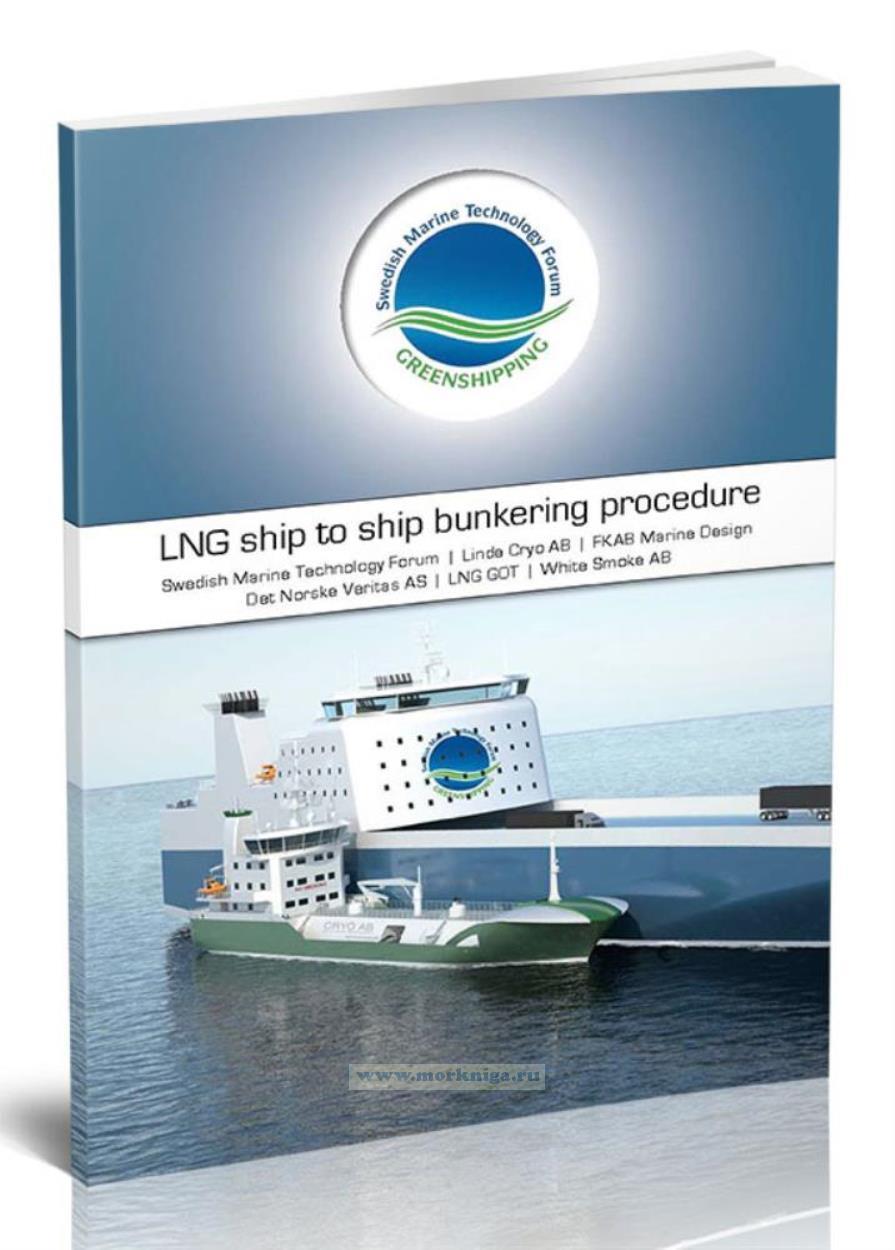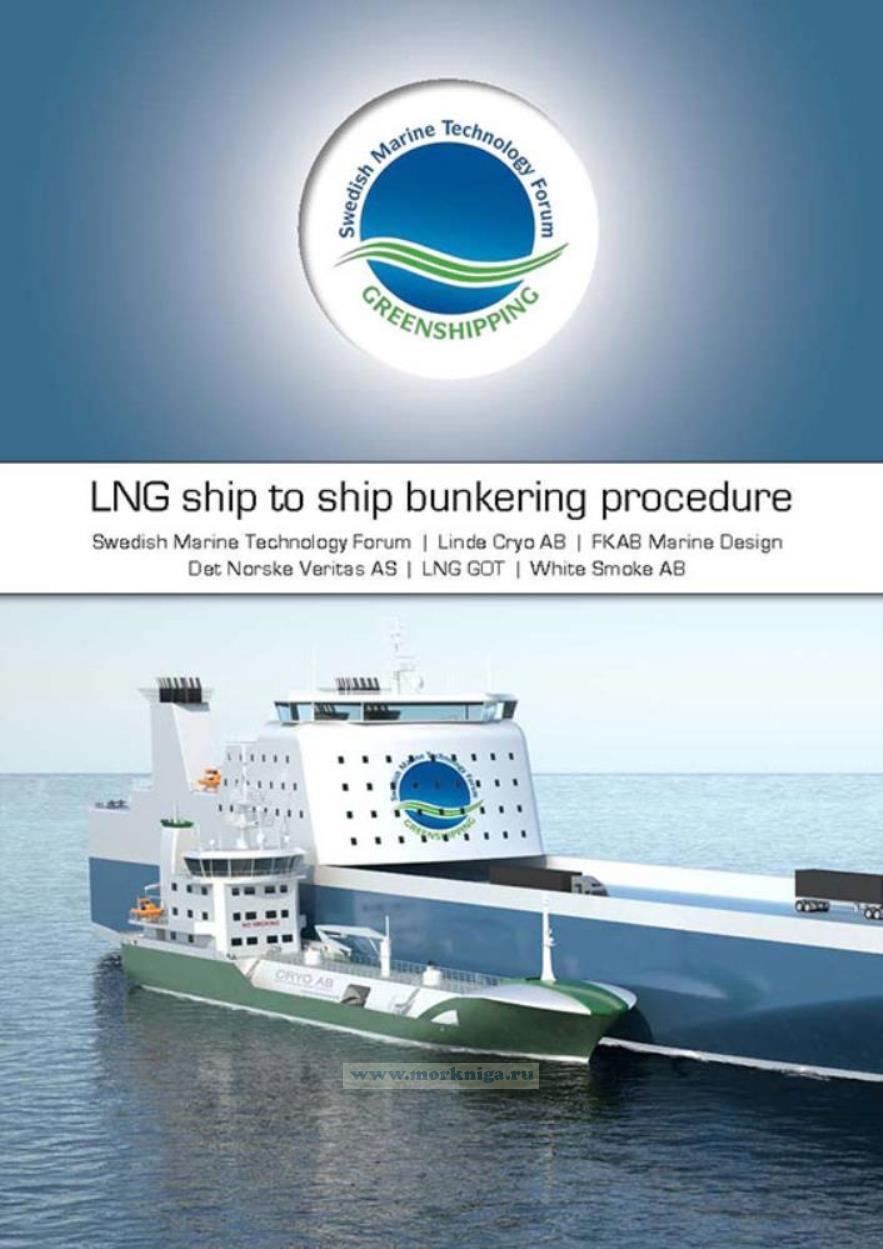LNG Ship to Ship bunkering procedure/Бункеровка СПГ методом судно-судно
Книга на английском языке.
This document is a procedural description of how LNG (liquid natural gas) bunkering between two ships should be done. The document is the result of the joint venture project “LNG bunkering Ship to Ship”, a technology development project carried out by Swedish Marine Technology Forum, FKAB Marine Design, Linde Cryo AB, Det Norske Veritas AS (DNV), LNG GOT and White Smoke AB.LNG bunkering ship to ship in port with demands for short operation time have not been performed be-fore and this procedure has been worked out to handle the specific details of this operation in a safe way. The procedure is made for ship to ship bunkering of LNG in a port environment, with a dedicated bunker ship rapidly delivering the fuel to client ships while cargo and passenger handling is still in progress. The project has developed a LNG bunkering concept that encompasses both the operational bunkering process and technical solutions needed for ship to ship bunkering of LNG. The conclusion of this study is that LNG bunkering ship to ship is indeed a suitable solution to provide environmentally friendly bunker fuel to larger ships.
Contents
Summary
Project Members
The Working group
The Reference group
Background
Project objectives
Approval in principle by DNV
Project Method
Rules and Guidelines
The Results
Preface - LNG bunkering ship to ship procedure
Bunkering Timeline
Glossary
1 General Principles
1.1 Scope
1.2 Control of operations
1.3 Responsibility
2 Conditions and Requirements
2.1 Approval
2.2 Ship Compatibility
2.3 Transfer Area
2.4 Weather Conditions
2.5 Light Conditions
3 Safety
3.1 General
3.2 EX-Zone
3.3 ESD-System
3.4 Check-Lists
3.5 Instructions (Routines)
3.6 Warning signs
3.7 Safety during Bunker
3.7.1 Smoking and Naked Light
3.7.2 Earth on switchboard
3.7.3 Electrical Currents
3.7.4 Radio and Communication Equipment
3.7.5 Radar
3.7.6 Electrical storms
3.7.7 Fire-Fighting Equipment
3.7.8 Accommodation Openings
3.7.9 Safety Zone
3.7 Gas Accumulation
3.8 Maintenance
3.9 Redundancy
3 Personnel education and training
3 Personal protection equipment
3 Sharp edges
4 communications
4.1 Language
4.2 Communication between Ships
4.3 Procedure for Communication Failure
5 Operations before Bunkering
5.1 Preparations
5.1.1 LNG Tank System Check
5.1.2 Mooring Equipment Check
5.1.3 Bunker Hose Check
5.1.4 Oil Bunkering
5.2 Check-List Before Bunker
5.3 Call
5.3.1 Safe Communication
5.3.2 Mooring Plan
5.4 Manoeuvring
5.5 Mooring
5.5.1 Fender Positioning
5.5.2 Fender Type and Size
5.5.3 Mooring Operation
5.5.4 Mooring Lines Supervision
5.6 Connection Communication Link (Option)
5.7 Connection of Hoses
5.8 Bunker Hoses
5.8.1 LNG Bunker Hose and Vapour Return Hose
5.8.2 Oil Bunker Hose
5.9 Pre-Transfer Bunker Check List
6 Operations During Bunkering
6.1 Return of Documents
6.1.1 Signed Check-List
6.1.2 Signed document with Agreed Amount and Transfer Rate
6.2 Open Manual Bunker Valves
6.3 Ready Signal Both Ships
6.4 Pump Start Sequence
6.5 Bunkering
6.6 Pump Stop Sequence
7 Operations After Bunkering
7.1 Purging of Bunker Hoses.
7.2 Close Manual and Remote controlled valves
7.3 Disconnection of Hoses
7.4 Disconnection Communication Link (Option)
7.5 Delivery Bunker Document
7.6 Unmooring
7.7 Manoeuvring
7.8 Inerting of Bunker Lines
7.9 Check-list After Bunker
8 Equipmen
8.1 Bunker Hoses
8.1.1 Hose Standards
8.1.2 Hose Size and Length
8.1.3 Hose Handling
8.1.4 Hose Connection
8.1.5 Hose Inspection and Testing
8.1.6 Marking
8.1.7 Differential Pressure Measuring
8.2 Bunker Station (Receiving ship)
8.3 Break-away Coupling
8.4 Mooring Equipment.
8.5 Personnel Transfers
8.6 Lighting
8.7 Trays below manifolds
8.8 Gas Detectors
8.9 Fuel Quality Measuring (Option)
9 LNG Cargo System Description
9.1 General
9.2 Equipment
9.2.1 General data
9.2.2 Tanks
9.2.3 Pumps
9.2.4 Bunker Stations (System)
9.2.5 Piping System
9.2.6 Vacuum Insulated Pipes
9.2.7 Double Trunk Pipes
9.2.8 Safety Valves
9.2.9 Vent Mast
9.2 ESD System
9.3 Process.
10 ESD philosophy
10.1 Reference.
10.2 ESD Analysis
10.3 The Receiving ship
10.4 The Bunker ship.
10.5 Transfer Interface when Bunkering
10.6 ESD Philosophy
11 Emergency Operations
11.1 Emergency Signal.
11.2 State of Readiness for an Emergency
11.3 Contingency Planning
11.4 Emergency Situations.
11.5 Safety Drills
11.6 Advice on some Emergencies
11.6.1 Emergencies during Manoeuvring
11.6.2 Procedures for Communication Failure.
11.6.3 Activation of Emergency Shut-Down Systems (ESD)
11.6.4 Procedures for Leakage / Gas Accumulation
11.6.5 Accidental LNG Bunker Fuel Release
11.6.6 Accidental Oil Bunker Fuel Release and Oil Pollution Control
12 GAS Handling
12.1 General
12.2 Safety Information
12.2.1 Cryogenic Liquids.
12.2.2 Risks when inhaling Methane (CH4) Natural Gas.
12.2.3 Risks when inhaling Nitrogen (N2) Gas
12.2.4 Fire
12.2.5 Risks when in contact with Cold items and Gas.
12.2.6 Personal Protection
12.2.7 Vapour Fog, Mist
12.2.8 Trapped Liquid
12.2.9 Training
References
Appendix A Check-List Before Bunkering
Appendix B Check-List Pre-Transfer
Appendix C Check-List After Bunkering
Appendix D - Flow Diagram LNG Ship to Ship bunkering
Appendix E - LNG Cargo System P&ID

